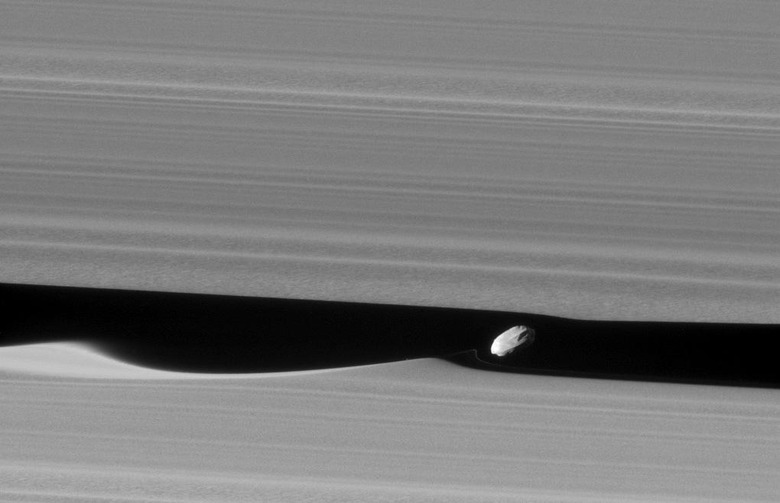You Have To See NASA's Latest Cassini Image From Saturn
Epic photos from NASA's space missions aren't a rare occurrence, but they don't come more dramatic than the latest image beamed back by the Cassini spacecraft. Currently in close orbit around Saturn, as it prepares to enter the final stages of its long mission, Cassini snapped the closest-ever photo of Daphnis, known as the planet's "wavemaker moon". The orbiting rock is just five miles across.
The photo, taken on January 16, 2017, caught Daphnis sandwiched within the Keeler Gap, a 26 mile wide split in the so-called A Ring surrounding Saturn. Approximately 155 miles from the ring's outer edge, the Keeler Gap is kept clear of debris by Daphnis itself. The angle at which Cassini took the photo makes the gap itself look much smaller than it actually is.

However, it's more than sufficient to see some of the elements that astronomers have been speculating about. For instance, there are waves in the edges of the Keeler Gap either side of Daphnis, where the moon's scant gravity has an impact. Closer examination, meanwhile, reveals softer edges at the wave peak in the gap edge – to the left in this photo. That, NASA suggests, is where fine ring particles have been spread slightly, following a closer approach by the moon in an earlier orbit.
Similarly, the narrow flurry of what's believed to be ring material just behind the moon is likely to be a packet of those particles brought out by Daphnis' proximity. Cassini snapped the image from around 17,000 miles away, using its narrow angle camera that captures in visible light. Each pixel in the original shot is equivalent to 551 feet.
The image follows an earlier shot of another of Saturn's moons, Mimas. Nicknamed "the Death Star" because of its distinctive circular crater and its resemblance to the planet-destroying space station in the Star Wars movies, it was captured on camera by Cassini back in October 2016, though NASA only released the image – post-processing – this month. The scale of the two moons is dramatically different, mind: at 86 miles across, the Mimas crater itself could swallow up Daphnis with plenty of room to spare.
Despite sending back hitherto-unseen material from Saturn, Cassini's days are nonetheless numbered. As of April 2017, the spacecraft will begin the final stage of its mission. With fuel supplies dwindling, Cassini's last route will be a tight orbit of the planet followed by a dash down through Saturn's atmosphere.
The hope is that there'll be enough time to return some final data to the Jet Propulsion Lab managing the Cassini project as it plummets, just as the Huygens probe did on its descent to Saturn's moon Titan several years ago. NASA released a video showing just what that might have looked like yesterday; the probe beamed back a few minutes of data before Cassini was out of range.
MORE NASA
